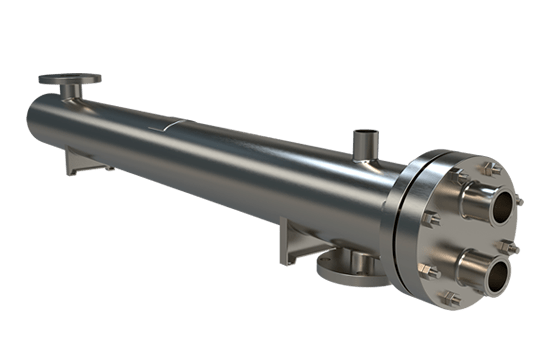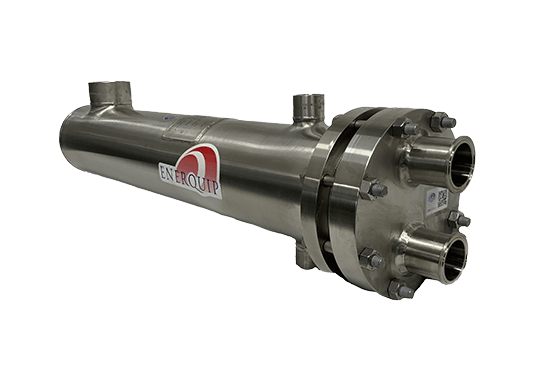Shell and Tube Condensers
With deep expertise in ASME Code, TEMA standards, and extensive industry experience, our engineering team is well-equipped to design condensers tailored to even the most demanding applications, process conditions, and space constraints. Whatever your needs, we can provide a vapor condenser solution that fits perfectly.
- Condensation Process: Condenser heat exchangers cool a vapor or gas, causing it to condense into a liquid by transferring heat to a cooler medium, typically water or air.
- Common Applications: Widely used in industries like HVAC, power generation, refrigeration, chemical processing, and food and beverage production.
- Heat Transfer Efficiency: The effectiveness of a condenser is influenced by factors such as surface area, temperature difference between the fluids, and the flow rate of the cooling medium.
- Customization: Many condensers can be customized with features like multiple passes, enhanced surface areas, and advanced coatings to optimize performance for specific processes.
- Fouling Resistance: Our condensers are designed with maximum fouling resistance through a careful choice of material, surface finishe and allowed roughness (Ra).
- Material Choices: Condensers are made from materials like 304L stainless steel, 316L, titanium, or higher alloys selected based on the thermal conductivity and required properties.
Stock Units
Sanitary Applications
- Evaporators & Condensors
- Clean-in-Place
- Bio-Tech

Custom Units
Sanitary Applications
- Brewery & Distillery
- Food & Beverage
- Dairy Pasteurization

Condensing Heat Exchangeres
Understanding Vapor Condensers and Their Applications
Vapor condensers function by cooling vapor until it transforms back into a liquid. This process occurs within a heat exchanger, where the vapor comes into contact with cooler surfaces, usually tubes. The heat from the vapor dissipates, causing it to condense into liquid form.
The resulting liquid is then collected in a separate container, while any uncondensed vapor is either released or returned to the original process.
These condensers are used across many industries—such as power generation, renewable fuels, chemical processing, refrigeration, cannabis, food and beverage, and pharmaceuticals—for recovering valuable products or reducing emissions of harmful gases.
Types of Vapor Condensers
There are several common types of vapor condensers, with shell-and-tube designs being particularly popular.
Solvent Recovery Condensers
In solvent recovery systems, vapor condensers are essential for reducing emissions and reclaiming valuable solvents. These condensers work by cooling vapor so that the solvent can be captured as a liquid and either reused or safely disposed of. They are designed to operate efficiently under both vacuum and pressure conditions.
Reflux Condensers
Reflux condensers are crucial in processes where vapor needs to be condensed and returned to the system. Often attached directly to a tank or reactor, these condensers cool rising vapors, causing them to condense and flow back into the tank. This process improves system efficiency and control. These condensers can also be configured as independent units and installed in either vertical or horizontal orientations.
Knock-back Condensers / Cold Trap Condensers
In knock-back and cold trap setups, vapor condensers are vital for capturing and condensing vapors. These vertical U-tube units, featuring removable tube bundles, allow vapors to contact cooled tubes and condense. The condensate is then drained from the shell, ensuring effective vapor removal. The design may include an extended shell section to collect condensate separately from the tube bundle.
Pharmaceutical Condensers
For pharmaceutical applications, maintaining product purity during condensation is critical. These condensers feature polished surfaces for product contact and sanitary tri-clamp connections adhering to ASME-BPE standards, ensuring the highest hygiene levels. Typically, these units condense vapor on the tube side, with options for single or double tube sheet designs. Finishes such as electro-polishing and materials like 304L or 316L stainless steel and Hastelloy are available to meet specific needs.
Terpene & Oil Condensers
In the essential oils and CBD processing industries, vapor condensers are crucial for maintaining product quality and safety under extreme conditions. These units focus on sanitary design and adhere to ASME certifications, ensuring that the integrity of the product stream is preserved while meeting all safety regulations. They effectively condense vapors, enabling the collection of high-purity essential oils and CBD extracts.
Emissions Abatement Condensers
Vapor condensers are key in emissions control, capturing and condensing volatile organic compounds (VOCs) and other hazardous vapors. By cooling these vapors in the condenser, they are transformed into liquid, which can then be safely collected and disposed of or recycled. This process significantly reduces the emission of harmful gases, improving air quality and ensuring compliance with environmental regulations.
Vacuum System Condensers
In vacuum systems, vapor condensers are essential for maintaining effective vacuum conditions. By removing condensable vapors from the system, these condensers lower pressure, protect vacuum pumps from potential damage, and reduce efficiency losses. This vapor removal reduces the load on vacuum pumps, leading to lower energy consumption and operational costs while maintaining stable vacuum levels—critical for processes requiring precise pressure control.
Customizing Your Vapor Condenser
We offer extensive customization options for vapor condensers to meet your specific needs.
Technical Specifications & Options:- Sizes: Up to 48” diameter (or larger depending on weight)
- Styles: U-tube, straight tube, single-pass or multi-pass configurations
- Materials: 304 SS, 316L SS, Duplex, Hastelloy, and AL6XN
- Standards: TEMA, ASME, 3-A, PED, and CRN
- Additional Design Options: Electropolished tube surfaces, passivation, sight glasses, level gauge ports, CIP spray ball assemblies, condensate collection sumps/chambers, and more.


